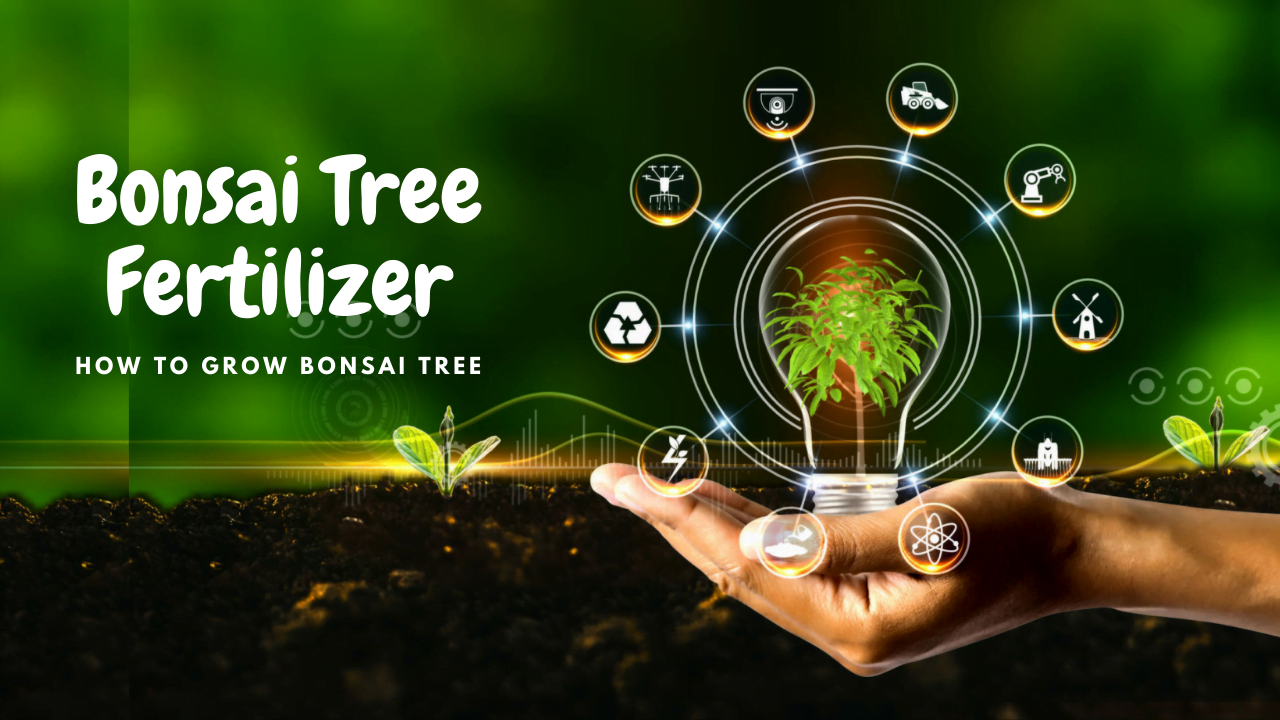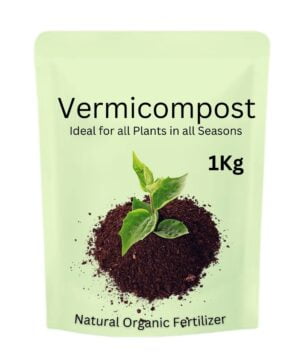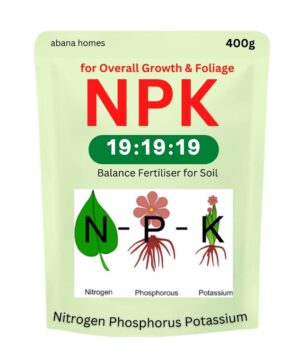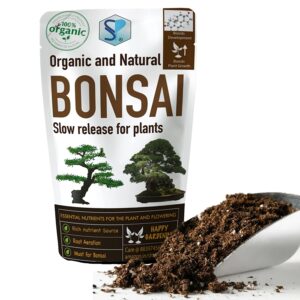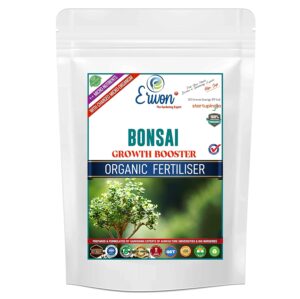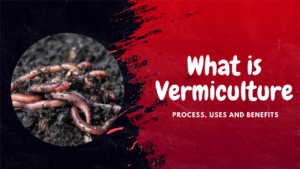Sometimes it is difficult for beginners to figure out how to care for their plants properly.
Is it also difficult to decide which type of fertilizer is best for your bonsai tree?
No problem, we’ve done our research and got some answers for you.
As we begin, we will cover all things about bonsai tree fertilizer. When to fertilize your bonsai tree, the right quantity to use, the main components needed for your bonsai tree, and many more things. With that said, let’s dive deep into this article,
Indoor bonsai trees are a beautiful addition to any home or office. These miniature trees can add a sense of peace and tranquility to your space, while also improving air quality. With proper care and attention, an indoor bonsai can thrive for years, bringing joy and beauty to your environment.
Why Bonsai Trees Need Nutrients
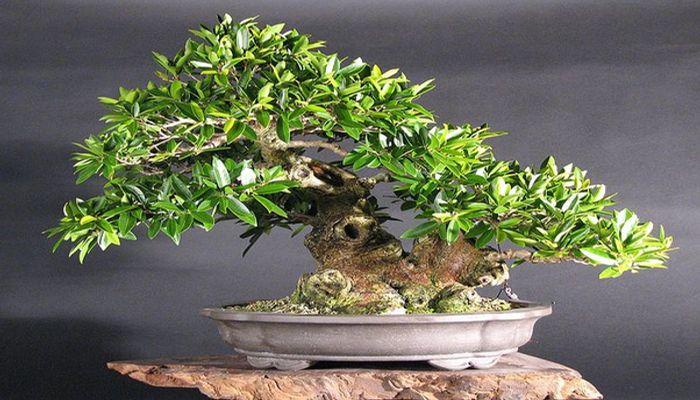
Root systems of regular trees are thick and complex, reaching deep into the soil to get nutrients. Conversely, bonsai tend to be potted for their aesthetic value rather than their practical importance.
This plant lacks enough room or soil to access nutrients and oxygen. Therefore, bonsai plants and trees must be supplemented with nutrient feedings to compensate for the lack of soil.
Moreover, a bonsai tree isn’t hard to please, and your bonsai tree needs six primary nutrients that are,
- Carbon
- Hydrogen
- Oxygen
- Nitrogen
- Phosphorous
- Potassium
The first three elements on this list are found in the environment naturally; nitrogen, phosphorus, and Potassium come from supplements. To ensure your tree gets these nutrients, the best way is to use a fertilizer that contains them, which is why fertilizing bonsai is so crucial.
Fertilizer provides necessary minerals and vitamins to turn carbon dioxide and water into food through photosynthesis. All the fertilizers purchased online from local garden shops or nurseries are composed of the three major elements needed for plant growth.
These three elements are Nitrogen, Phosphorous, and Potassium (NPK). All quality fertilizers are marked with an NPK value to help users understand the composition of nutrients in their formula. Each of these elements helps the plant in its way.
Basic components of fertilizer
There are three basic elements: Nitrogen, Phosphorous, and Potassium (NPK). Nitrogen is responsible for the growth of leaves and stems or above the ground. At the same time, phosphorus contributes to the growth of roots, fruits, and flowers. And Potassium for overall plant health.
Growers use different ratios of NPK for different trees at different times. But experts suggest using the same NPK ratio throughout the bonsai growth cycle.
Apart from these three major macronutrients (NPK), include a range of micronutrients like Iron, Manganese, Boron, Molybdenum, zinc, and copper in the fertilizer.
When should I apply fertilizer?
The fertilizer should be applied during the entire growing season, early spring through mid-fall. Older and more mature bonsai trees are often fertilized less frequently, depending on the tree species, time of year, development stage, and overall tree health. But you can fertilize indoor trees all year round.
Which fertilizer to choose?
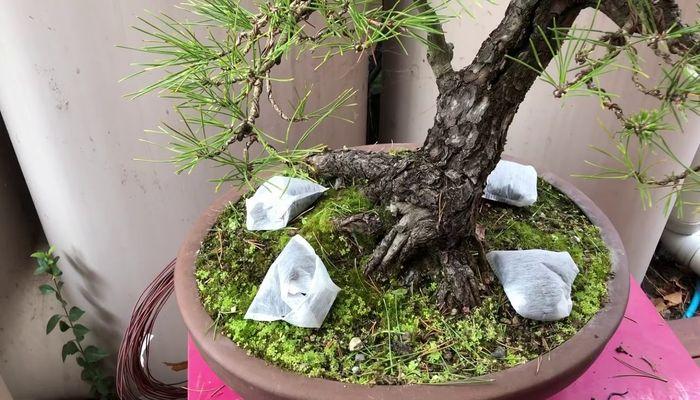
It is best to use slow-release or continuous-release fertilizers on bonsai. In general, you should look for a fertilizer that contains nitrogen, phosphate, and potassium. This mixture will provide your plants with everything they need to thrive.
Also, it is essential to choose the right bonsai fertilizer for your tree and apply the right quantities. For outdoor bonsai, use a relatively high Nitrogen fertilizer like NPK 10:6:6 in spring. In summer, a more balanced fertilizer is required, like NPK 6:6:6. And a low nitrogen fertilizer like NPK 3:6:6 is optimal for autumn.
There are many fertilizers, including liquid, solid, synthetic, and organic. The type of fertilizer you use doesn’t matter, but you must be sure to follow the instructions on the package for application.
Liquid vs. Solid Bonsai Tree Fertilizer
Bonsai tree fertilizers are available in two forms: liquid and solid fertilizers. Naturally, the best fertilizer is the one that contains the “big three” nutrients. Though liquid and solid fertilizer each have their way of benefiting the plant.
Liquid Fertilizer: The liquid form of a concentrate is an effective method of replenishing nutrients. Liquid fertilizer leaches from the soil every time it is watered, so it is important to water regularly when using liquid fertilizer.
Solid fertilizer: It is also known as granular fertilizer. Solid fertilizer spreads on the surface layer of the soil. The slow-release approach of solid fertilizer diffuses into the soil over time and requires less upkeep, but there is a greater risk of burning the plant’s root with solid fertilizers. In addition, it isn’t easy to know when to reapply slow-release fertilizer.
Organic vs. Synthetic Bonsai Tree Fertilizer
Organic and synthetic fertilizer provides the necessary nutrients the bonsai tree needs to grow. Organic fertilizer is derived from natural sources such as manure, fish, or seaweed. And synthetic fertilizers are formulated chemically.
Some people find natural, organic fertilizer appealing, whereas others prefer synthetic fertilizer for the higher nutrient concentration. To keep your tree happy either way, follow the product instructions.
Urea-Free Fertilizers
For the grower, who is likely to use synthetic fertilizer, we recommend avoiding products that contain urea. It is a synthetic chemical widely used in fertilizer to replenish nitrogen. However, because of its extremely high nitrogen levels, it can be detrimental to the delicate tree that is growing in limited soil.
Buy Best Fertilizer for Bonsai Plants
- ₹150 – ₹375
- ₹158 – ₹405
Bonsai Tree Fertilization: A Beginner’s Checklist
Step 1: First and foremost, always read the fertilizer package’s directions and follow the instructions that accompany a new bonsai tree.
Step 2: Choose a bonsai tree fertilizer type for your tree. Select the one that works best for your bonsai tree. It is recommended to use a liquid solution with every watering. You can also buy a liquid urea-free fertilizer online.
Step 3: Always create a feeding schedule based on your tree type and growing season for your bonsai tree. It will ensure timely feeding to your plant.
Step 4: Monitor your bonsai tree. Keep an eye out for signs of over or under-fertilization and check what your tree responds well to. Note down your observations and modify them as needed.
Step 5: Consistency is important. When you have found fertilizer, your bonsai tree responds well; stick to that approach.
How much fertilizer should I apply?
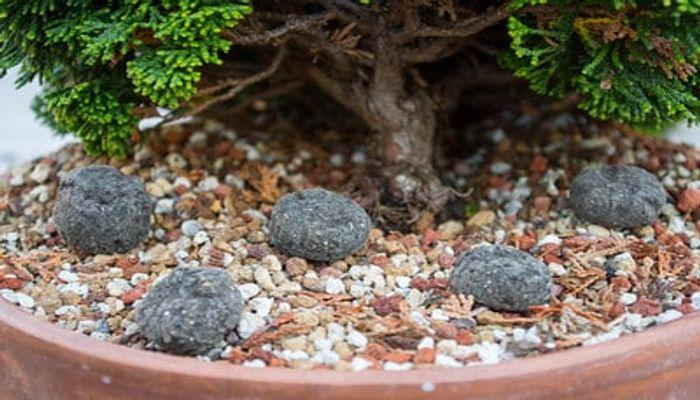
The quantity and frequency of using fertilizer depend on which fertilizer you buy. Follow the instructions on your fertilizer package to ensure you feed your bonsai tree correctly. Also, ensure the bonsai tree is planted in proper, well-draining bonsai soil to prevent a build-up of salts.
Additionally, you can choose to smooth out tree growth instead of stimulating it by sightly reducing the recommended quantity of trees that are no longer in training. If you are using solid fertilizer, use fertilizer covers to make sure the fertilizer stays in place. Also, never overfeed your bonsai tree, as this will seriously affect the tree’s health.
FAQs
1. When should I fertilize my bonsai?
Bonsai trees are cultivated in a limited amount of soil. Therefore, fertilizer is important. During the growing season, the bonsai trees should be fed weekly with a bonsai fertilizer. Also, remember that your bonsai may stop absorbing nutrients during late summer and early fall.
You should also reduce fertilization when the growth begins to slow down. Scheduling it only once a month is fine. Below are some guidelines for specific classes of bonsai.
| Deciduous bonsai tree | Fertilize the bonsai tree weekly during the growing season and stop when the leaves have fallen.During the fall and winter months, feed the tree with a 0-10-10 fertilizer. |
| Conifers bonsai tree | During the growing season, fertilize the bonsai tree weekly. The bonsai tree will also benefit from being fertilized a few times in winter.For the fall and winter, apply 0-10-10 fertilizer. |
| Tropical and sub-tropical bonsai tree | Fertilize the bonsai tree weekly during the growing season. The tree will continue to grow throughout the year.And feed the bonsai tree every month basis from fall to spring. |
In any case, do not starve your bonsai tree. Bonsai tree fertilizer helps keep the tree small and prevents the bonsai plant from getting spindly. Also, remember never to feed a sick bonsai; feed only healthy trees!
2. Which type of fertilizer is best for a bonsai tree?
The best fertilizer is a bonsai fertilizer specifically formulated to provide an optimum level of salt in the soil solution when used as recommended.
Let us understand this in more detail and easy way,
Fertilizer is simply an alternate source of all the basic nutrients such as nitrogen, phosphorous, potassium, and trace minerals that exist in healthy soil naturally.
Also, understand that fertilizer feeds the soil, not your bonsai. Fertilizer breaks down in the soil by dissolving in water or by microbial action, releasing the nutrients in a form that plant roots can absorb.
Bonsai tree uses nitrogen for leaf production, phosphorus for root and flower production, and potassium for flower production and general vigor.
Generally, general-purpose fertilizer is balanced; it contains all the major nutrients in the same proportions. As a result, these general-purpose fertilizers are well-suited for lawns, trees, shrubs, flowers, and even vegetable gardens where there are no special problems with the soil.
The special-purpose fertilizer is unbalanced, featuring a greater proportion of one of the major nutrients that suit particular situations or bonsai. For example, bonsai fertilizer for acid-loving plants such as azaleas provides iron in a form that these plants can use.
While using fertilizer, let the given direction on the package be your guide, and whenever possible, use a specialized bonsai tree fertilizer to maintain its health.
3. What is NPK?
Don’t let the tree-number code on bags of fertilizer scare you. NPK indicates nitrogen (N), phosphorus (P), and potassium (K).
Nitrogen: For the intensity of the color green in plant
Phosphorous: For maintaining the root system and blooming and fruiting.
Potassium: Overall health of the plant.
4. What is the difference between liquid fertilizer and granular?
Fertilizers are available in two types: liquid and granular (pellets). Select the one that meets your needs and is easy for you to use.
Liquid fertilizer acts fast and absorbs quickly. However, they require more application. When you water the bonsai tree, you wash away the fertilization previously applied.
Granular fertilizers are applied dry and should be watered in. They are easy to control because you can see how much fertilizer you use and where it is dispersed.
Both types of fertilizer are appropriate for bonsai gardeners, and mostly bonsai gardeners use both types of fertilizer for maximum balance.
5. What is the advantage of using organic fertilizer?
Bonsai tree needs N, P, and K; they are the major elements. The major benefit of using organic fertilizer is that it releases nitrogen slowly and is less likely to burn the roots if accidentally over-fertilized.
Some fertilizers, such as chicken manure or liquid fishmeal, have a distinct odor, so they are less likely to be used. However, not all organic fertilizers smell bad.
Moreover, organic fertilizer does not contain all trace elements and minerals. Therefore, several different organic fertilizers are used. Therefore, it would be a good idea to use alternative fertilizers (organic and non-organic) to give the bonsai a mixture of trace elements.
Also, no matter which fertilizer you apply, the important thing is to follow the direction given on the package. Using too much fertilizer or too frequently increases the risk of damaging your bonsai tree.
6. When should I avoid fertilizing my bonsai tree?
It would be best if you never fed a tree under stress, a newly repotted tree, a dry tree, or a tree during dormancy. Do not feed the tree at least for a month after repotting.
7. Is it worth spending money on using Superthrive?
When you ask gardeners what soil mix is best for your bonsai tree, you are more likely to get several different answers, and the same is for Superthrive.
Many gardeners promise that Superthrive will make a big difference in the plant. But it seems that almost as many say, it makes no major difference; it is a waste of money.
You will find the guarantee on the Superthrive’s brochure or container that the product will do everything in the world: 60 years unchallenged, grower, activator, transplanter, and many more.
But they do not include a list of ingredients, only touting 50 vitamins and hormones. Therefore, if you plan to use the product, we recommend you follow the mixing instruction of 1 drop per gallon as we do not know the ingredients. Moreover, Superthrive is not a fertilizer. Therefore you may use it in addition to ordinary fertilizer or plant food.
8. Should I add trace elements to the soil?
All organic matter contains various trace elements, often found in the dorm of soil or fertilizer. But the level in soil and fertilizer is not enough for long-term growth.
But there are products such as FRIT that help fill the trace element void. It contains more than 28 trace elements and minerals on the major and minor scales that are vital for the health of the bonsai tree.
FRIT is a dual-acting compound that releases the major trace elements over 12 months. Because 30% of the compound is soluble in the first hour, your bonsai tree gets an immediate infusion of needed trace elements. After that, the remaining 70% of the compound is released slowly and evenly.
Conclusion
There is no doubt that bonsai trees and plants can benefit greatly from fertilizer and nutrients, but as a diligent grower, make sure you know what’s the best formula will suit your plants and the right time to feed them. There are many different varieties and brands of fertilizer.
There are organic, non-organic, liquid, and granulated nutrients. You will also find fertilizers in varying nutrient levels to fit your bonsai tree developmental stages.
All these could be overwhelming for any beginner bonsai grower, but in time, you will be able to use fertilizer on your bonsai plants confidently and expertly.
In the comment section, let us know which bonsai fertilizer you prefer for your bonsai tree?
Related Articles
- Top 10 Organic Fertilizers: Boost Your Plant Growth Naturally
- NPK Fertilizer: Everything you need to know
- What Are The Advantages And Disadvantages Of Vermicomposting?
- Fertilizer for Indoor Plants: How and When to Fertilize Houseplants
- Bonsai Tree Fertilizer 101: Essential Nutrients and Techniques for a Thriving Tree
- What is Vermiculture: Process, Uses and Benefits

